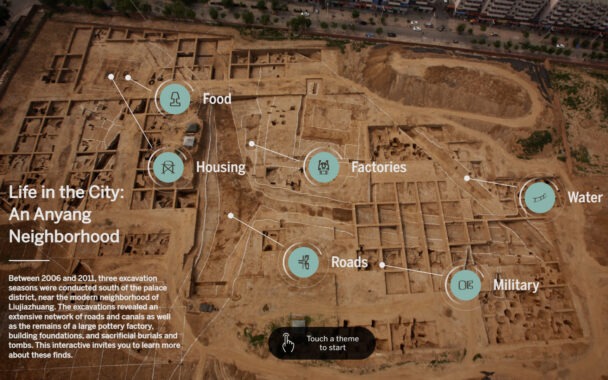This interactive experience explores daily life in the ancient city of Anyang, the final capital of China’s Shang dynasty. Over the last two decades, archaeologists have begun to explore Anyang’s urban landscape. Excavations on the south side of the city, near the modern neighborhood of Liujiazhuang, have revealed an impressive network of roads and canals, remains of a large pottery factory, foundations for a courtyard building, and numerous sacrifical burials and tombs.
Life in the City: An Anyang Neighborhood


Life in the City: An Anyang Neighborhood was designed in collaboration with Unit9. All images are courtesy of the Institute of Archaeology, Chinese Academy of Social Sciences.
The excavations at Liujiazhuang were conducted by the Anyang Archaeological Team of the Institute of Archaeology, Chinese Academy of Social Sciences. The work was led by Tang Jigen (former head of the Anyang field team), Yue Hongbin, Yue Zhanwei, He Yuling, and Niu Shishan. English translations of the Anyang Archaeological Team’s excavation reports include:
“2008 Excavation at Locus North of Liujiazhuang within the Yinxu Site, Anyang City, Henan.” Chinese Archaeology 10 (2010): 24–30.
“The Excavation at Liujiazhuang Locus North at Yinxu Site in Anyang City, Henan in 2010–2011.” Chinese Archaeology 14 (2014): 102–110.
“The Excavation of the Pottery Workshop Site at Liujiazhuang Locus North of Yinxu in Anyang City, Henan.” Chinese Archaeology 14 (2014): 111–17.
“The Bone Workshop Site of Yinxu Period at Tiesan Road in Anyang, Henan.” Chinese Archaeology 17 (2017): 128–37.
“The Excavation of Burial M89 at Tiesan Road at the Yinxu site at Anyang, Henan.” Chinese Archaeology 18 (2018): 89–100.
“The Excavation of a Cache of Lead Ingots in Liujiazhuang Locus North of Yinxu, Anyang, Henan.” Chinese Archaeology 21 (2021): 125–32.
Illustrations for this feature derive from these excavation reports as well as from images provided by the members of the Anyang Archaeological Team who led the work at the site. Special thanks are extended to Tang Jigen for providing diagrams and behind-the-scenes images of archaeologists at work at the Anyang site drawn from his book, A Brief History of the Excavations at Yinxu (1928–2018): Beijing, Social Sciences Academic Press, 2018. Additional publications that have contributed to the content of this presentation include:
Anyang Archaeological Team. “Tomb 1046 to the North of Liujiazhuang at the Yinxu Site in Anyang.” Kaoguxue jikan 15 (2004): 359–89.
Anyang Archaeological Team. “The Excavation of Dasikong Village Locus Southeast of the Yinxu Site in Anyang in 2015-2016.” Acta Archaeologica Sinica 4 (2019): 503–64.
Institute for Archaeology, Chinese Academy of Social Science and Institute of Cultural Relics and Archaeology of Anyang. Yinxu xin chutu qingtongqi. Kunming: Yunnan People’s Publishing House, 2008.
Institute of Cultural Relics and Archaeology of Anyang. Report on the Excavations at Xujiaqiao and Guojiazhuang in Anyang, 2004-2008 Yinxu Archaeological Report. Beijing: Science Press, 2011.
Tang Jigen, Jing Zhichun, Yue Hongbin, He Yuling, Niu Shishan, and Yue Zhanwei. “The Roads and Water Networks of the Huanbei Shang City and Yinxu Sites.” Acta Archaeologica Sinica 3 (2016): 319–42.
Wang Shuzhi, Yue Hongbin, Tang Jigen, Yue Zhanwei, He Yuling, and Zhao Zhijun. “The Use of Trees in the Mid-term and Late of Shang Dynasty—The Analysis of the Trees Remains Unearthed in the Huanbei Mall and the Yin Dynasty Ruins.” Cultural Relics of Southern China 3 (2014): 117–29.
Zhang Hua, Deborah C. Merrett, Jing Zhichun, Tang Jigen, He Yuling, Yue Hongbin, Yue Zhanwei, and Yang Y. Dongya. “Osteoarthritis, Labour Division, and Occupational Specialization of the Late Shang China—Insights from Yinxu (ca. 1250–1046 B.C.).” PLOS ONE 12, no. 5 (2017): n.p. https://journals.plos.org/plosone/article?id=10.1371/journal.pone.0176329.

